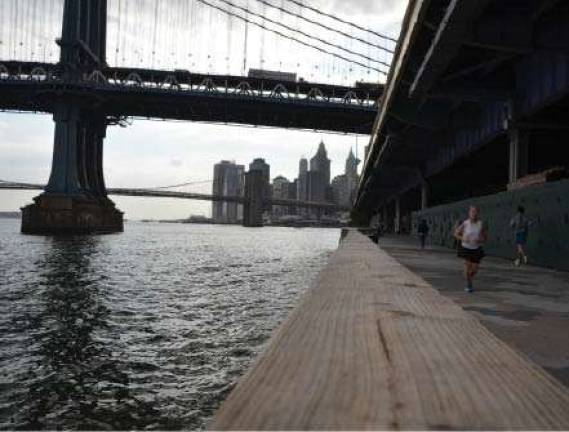A Conservancy For The East River

Community stakeholders organize a pilot meeting for waterfront on the Lower East Side
Two-dozen people gathered in the community room of a NYCHA housing development on the Lower East Side to discuss forming a conservancy for the East River waterfront, the first of its kind, in an apparent attempt to gain some measure of community control over an asset they see as belonging to the community.
Present were members of community boards one and three, representatives of downtown elected officials, tenant leaders, neighborhood groups and those with experience in forming conservancies.
Two Bridges Neighborhood Association, who hired consultant Gina Pollara to guide discussions on forming the conservancy, is driving the effort. Pollara most recently helped form a conservancy at FDR Four Freedoms Park on Roosevelt Island.
"Two Bridges is a catalyst for this conversation," said Victor Papa, a Two Bridges board member.
Much remains unknown. At the very least, it seems the conservancy would like to oversee programming and any growth initiatives on the waterfront, including small business programs. In an email after the meeting, Pollara wrote to the steering committee that consensus on the north/south boundaries seemed to be "the southern end of East River Park ... to roughly Fletcher Street, just south of the Seaport Historic District."
However, that boundary is open to discussion, she said.
Those present also seemed to agree that the conservancy should operate as a local development corporation. An LDC is similar to an authority in that it forms to serve a public purpose yet stands apart from the public entity that created it. Unlike authorities though, LDCs are organized as private, not-for-profit corporations and are typically created by counties, cities or towns.
LDCs are also not bound by public procurement laws requiring contracts for goods and services to go to the lowest bidder. Lastly, LDCs are granted the power to acquire property from local government without appraisal or public bidding.
"We obviously want something that's nimble, and gives us the greatest latitude and economic ability," said Pollara, who favors the LDC model.
She said Seattle's Pike Place Market is a good example of what could work well along the East River. Pike Place, founded in 1907, is the oldest continually operating farmers market in the country with hundreds of farmers, craftspeople, small businesses and residents. The market itself generates most of its revenue, but they do get some funding from the state.
A 12-member council that's organized as a preservation and development authority determines the market's programming and future. The charter underpinning the authority requires it to preserve, rehabilitate and protect the market's buildings, which are landmarked, and support small businesses and provide services for low-income residents.
Of great concern to many at the meeting was keeping the waterfront in the hands of the community and uniting Chinatown and the Lower East Side with the rest of Lower Manhattan below the Brooklyn Bridge.
"There has to be an underlying principle that residents have a channel and a voice on [the conservancy]," said Papa. "How it works legally I don't know."
"I want the community, those of us citizens who live in the community, to have the most control," said Community Board 3 member Linda Jones. "Some of these conservancies are basically state entities, and that troubles me. I'd like us to have the most control, that the people who are running this be citizens of the neighborhood, not somebody the governor appoints."
Another issue is how the South Street Seaport would fit into the equation. Those at the meeting seemed to agree the seaport is a huge economic draw and should be included in the overall plan for a conservancy and the future of the East River waterfront. But mega-developer Howard Hughes has a 60-year lease on the seaport and is in the middle of negotiations with the city's Economic Development Corporation and the community on what exactly will be built there.
Laura Starr, with the urban landscaping firm Starr Whitehouse, said there are myriad issues to consider when it comes to the waterfront, in addition to the seaport, including hundreds of millions that are coming from the federal government for flood mitigation on the Lower East Side, NYCHA dysfunction, and other development interests in the neighborhood.
"I think it's lose, lose, lose if they all stay separate, so the question is how to integrate them," said Starr, who spent 12 years at the Central Park Conservancy during its formative years. "The whole area needs an economic engine that involves the community, that doesn't displace the community, that benefits the community."
For Papa, one of the biggest functions of any conservancy would be to unite Lower Manhattan, Chinatown and the Lower East Side, starting with the community boards.
"It does necessitate the involvement of community boards, and for us to go to the community boards and have these discussions," said Papa. "The Brooklyn Bridge is an artificial boundary."
Many questions remain, but next steps involve narrowing the possibilities of governance structures, conducting an economic feasibility study, defining the geographic boundaries of the conservancy, and getting the community boards more involved, said Papa. Also, coming up with a name.
Despite the massive scope of what's being considered, and the fact that the conservancy is still in its infancy, Papa said the guiding principle should be supporting the needs of people who live in the area.
"The question of what this is going to be is more answered by asking what are the needs and what are the express desires of the community?" he said.